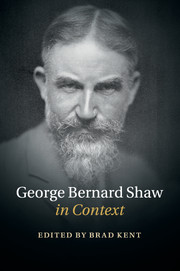Book contents
- Frontmatter
- Dedication
- Contents
- List of illustrations
- Notes on contributors
- Preface
- Acknowledgements
- A Chronology of Shaw's Works
- List of abbreviations
- PART I PEOPLE AND PLACES
- PART II THEATRE
- PART III WRITING AND THE ARTS
- 15 Cinema
- 16 Journalism
- 17 Letters
- 18 Media and technology
- 19 Modernism
- 20 Music
- 21 Novels
- 22 Publishers and publishing
- 23 Visual arts
- PART IV POLITICS
- PART V CULTURE AND SOCIETY
- PART VI RECEPTION AND AFTERLIFE
- Further reading
- Index
- References
17 - Letters
from PART III - WRITING AND THE ARTS
Published online by Cambridge University Press: 05 October 2015
- Frontmatter
- Dedication
- Contents
- List of illustrations
- Notes on contributors
- Preface
- Acknowledgements
- A Chronology of Shaw's Works
- List of abbreviations
- PART I PEOPLE AND PLACES
- PART II THEATRE
- PART III WRITING AND THE ARTS
- 15 Cinema
- 16 Journalism
- 17 Letters
- 18 Media and technology
- 19 Modernism
- 20 Music
- 21 Novels
- 22 Publishers and publishing
- 23 Visual arts
- PART IV POLITICS
- PART V CULTURE AND SOCIETY
- PART VI RECEPTION AND AFTERLIFE
- Further reading
- Index
- References
Summary
The topic of the letters written by a prominent literary figure is mandatory in the case of Bernard Shaw. The amazing number and dazzling versatility of his correspondence over eighty-plus years render him, with little doubt, one of the most prolific and consummate letter-writers of all time. When he was eighty-one, Shaw fended off a prospective publisher from collecting all that were still extant by telling him, ‘There are some billions of letters of mine in existence’. He repeated this to a similar applicant with an April Fool's Day twist in his ninety-third year: ‘There are billions of them, and I am adding to them every day’. This is a huge exaggeration of the quantity, but one whose impact it accurately conveys. As for quality, H. G. Wells finally shook off the relentless debunking that Shaw's letters inflicted upon him and conceded, ‘You write the most gorgeous letters! I bow down’. In his fifties, largely through letters first approved by his wife, Shaw romanced the alluring actress Mrs Pat Campbell so eloquently that she finally graced him with the tribute, ‘If I could write letters like you, I would write letters to God’.
A marked advantage over his avid letter-writing predecessors that Shaw enjoyed was a radical revision in the British postal system. Beginning in the 1830s, the procedures for paying the cost of letters to be sent and then mailing them, along with the increase in railways and steamships to deliver them, enlarged the volume of postal traffic to ten times its pre-reform level by 1870. London mailmen often picked up letters twice a day and delivered them on their ensuing routes. Postcards were also introduced. The conditions were ideal for Shaw's exploitation of this much-improved system. The same applied to others: Charles Dickens, the Carlyles, and the American William Gilmore Simms before him, followed by Mark Twain and Henry James. His younger contemporary Bertrand Russell, whose archives hold at least fifty thousand of his letters, offered competition, as did later literary figures to varying degrees: Willa Cather, Saul Bellow, C. S. Lewis, J. D. Salinger, Samuel Beckett. But no prominent English-language writer seems to have seriously challenged Shaw's eminence.
By far the most imposing source of these letters is Dan H. Laurence's edition, Bernard Shaw: Collected Letters, four fat volumes issued between 1965 and 1988.
- Type
- Chapter
- Information
- George Bernard Shaw in Context , pp. 135 - 142Publisher: Cambridge University PressPrint publication year: 2015



